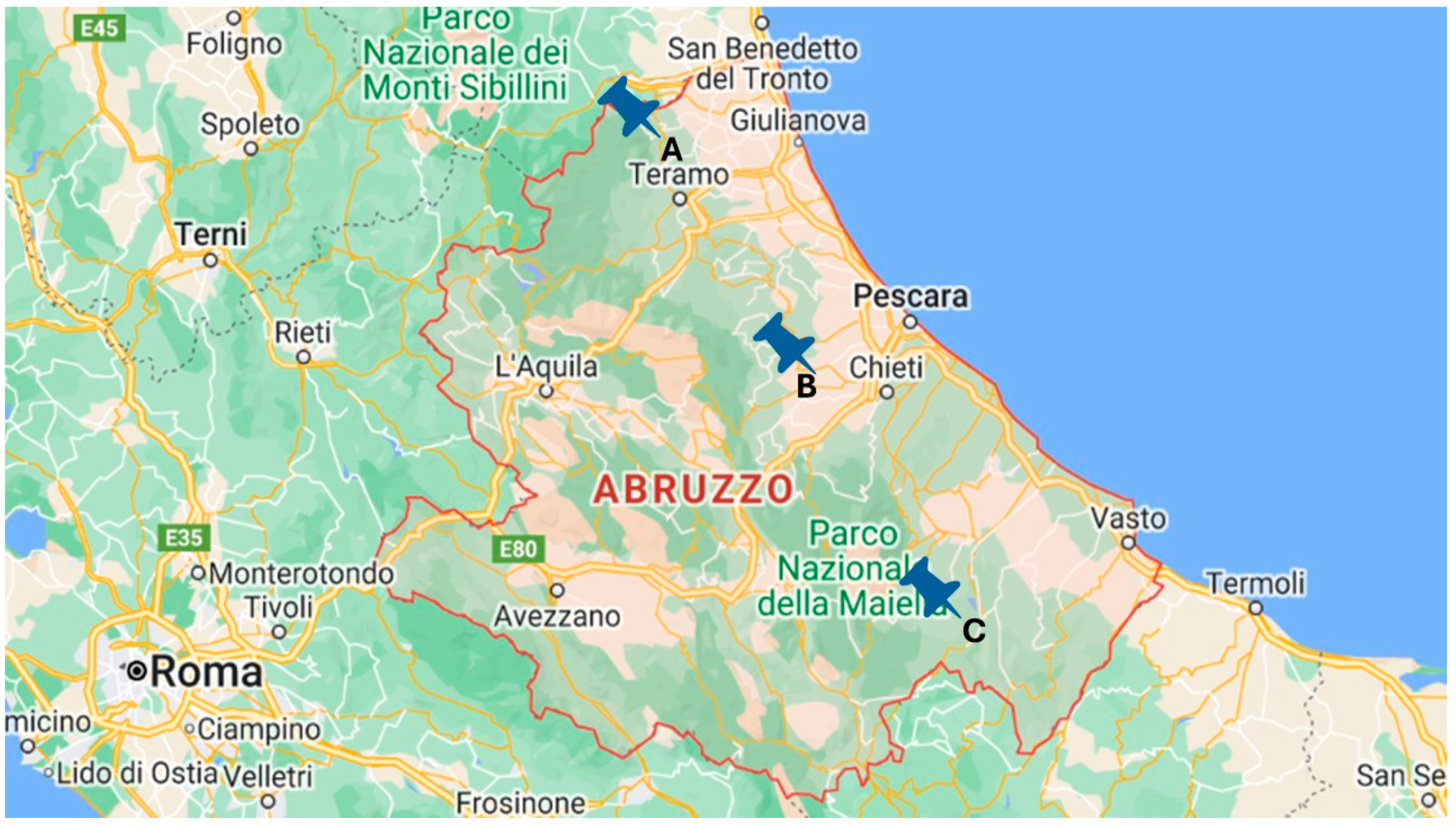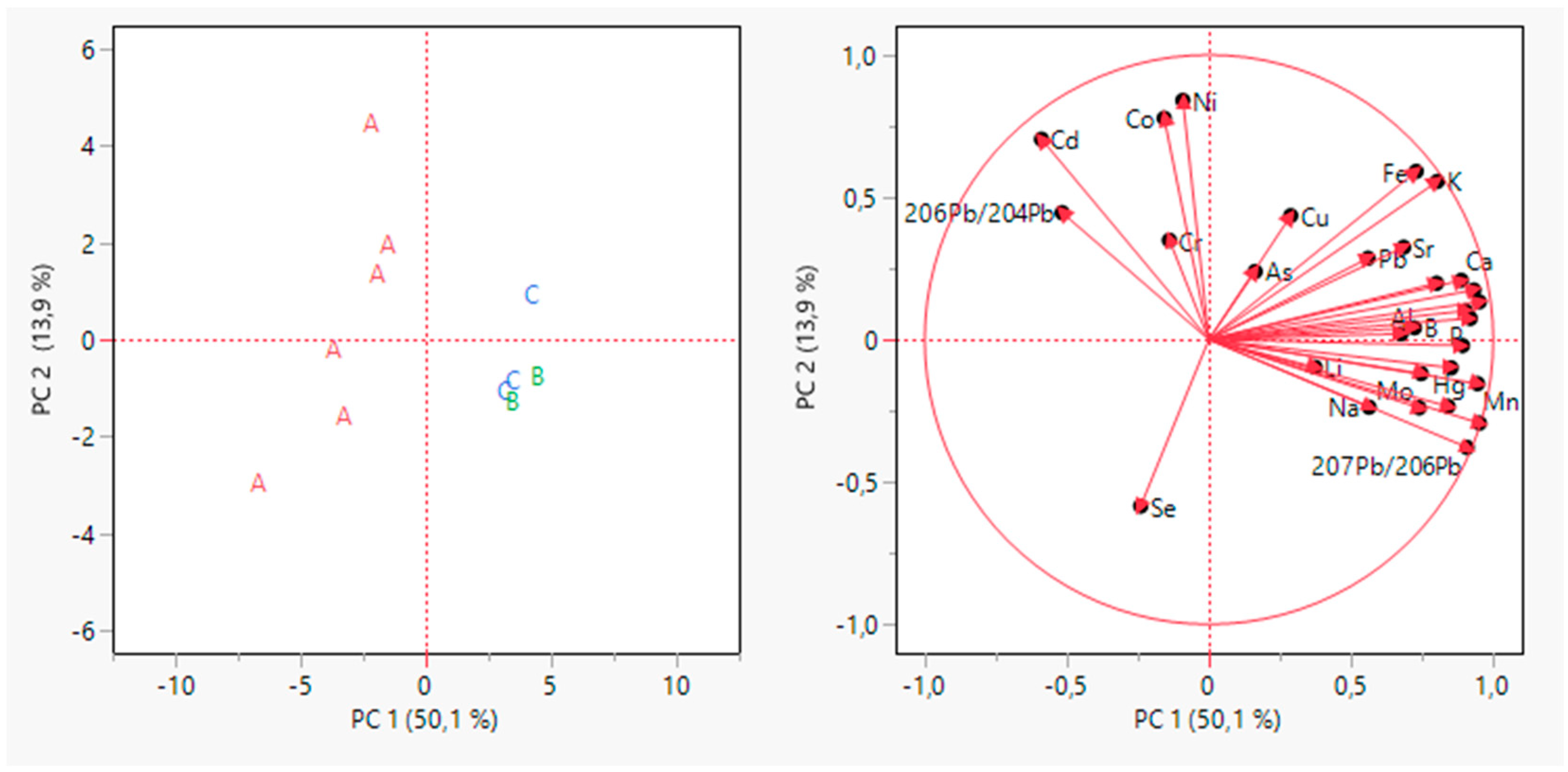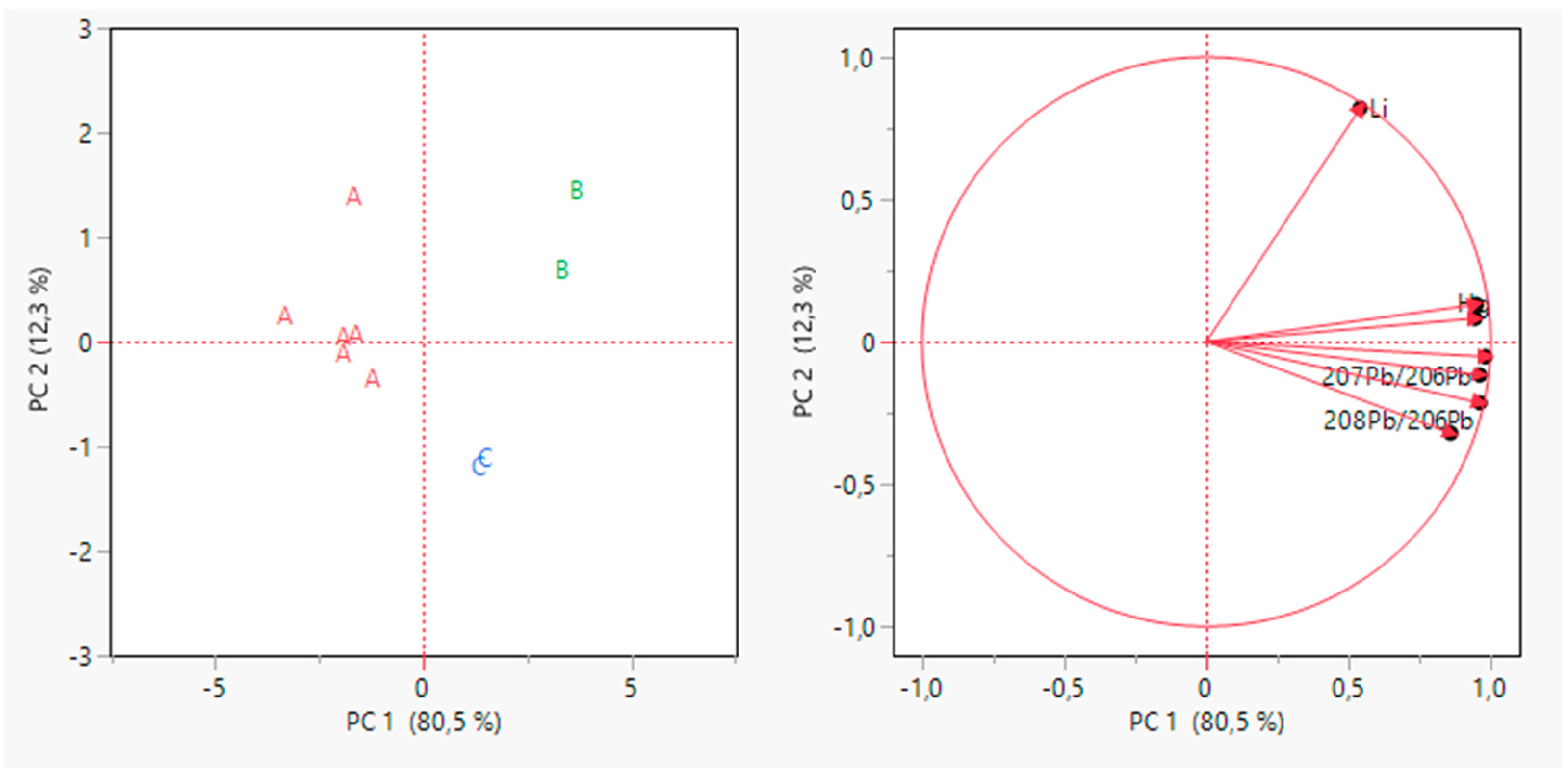Safety and Quality of Grapes: Elemental, Isotopic and Chemometric Analysis from Montepulciano d’Abruzzo PDO Chain
Abstract
1. Introduction
2. Materials and Methods
2.1. Chemicals and Reagents
2.2. Instrumentation
2.3. Sample Preparation and Analysis
2.4. Analytical Validation
2.5. Statistical Analysis
3. Results and Discussion
3.1. Multi-Element Analysis
3.2. Isotopic Analysis
3.3. Chemometric Assessment
4. Conclusions
Author Contributions
Funding
Institutional Review Board Statement
Data Availability Statement
Conflicts of Interest
References
- Feng, H.; Feng, J.; Tian, D.; Mu, W. Consumers’ Perceptions of Quality and Safety for Grape Products: A Case Study in Zhejiang Province, China. Br. Food J. 2012, 114, 1587–1598. [Google Scholar] [CrossRef]
- Reynolds, A.G. Managing Wine Quality: Viticulture and Wine Quality; Elsevier: Amsterdam, The Netherlands, 2010. [Google Scholar]
- Rubini, L.; Motta, L.; Di Tommaso, M.R. Quality-Based Excellence and Product-Country Image: Case Studies on Italy and China in the Beverage Sector. Meas. Bus. Excell. 2013, 17, 35–47. [Google Scholar] [CrossRef]
- Selma, M.V.; Luna, M.C.; Martínez-Sánchez, A.; Tudela, J.A.; Beltrán, D.; Baixauli, C.; Gil, M.I. Sensory Quality, Bioactive Constituents and Microbiological Quality of Green and Red Fresh-Cut Lettuces (Lactuca sativa L.) Are Influenced by Soil and Soilless Agricultural Production Systems. Postharvest Biol. Technol. 2012, 63, 16–24. [Google Scholar] [CrossRef]
- Christaki, T.; Tzia, C. Quality and Safety Assurance in Winemaking. Food Control 2002, 13, 503–517. [Google Scholar] [CrossRef]
- Battistelli, N.; Perpetuini, G.; Perla, C.; Arfelli, G.; Zulli, C.; Rossetti, A.P.; Tofalo, R. Characterization of Natural Oenococcus Oeni Strains for Montepulciano d’Abruzzo Organic Wine Production. Eur. Food Res. Technol. 2020, 246, 1031–1039. [Google Scholar] [CrossRef]
- Saranraj, P.; Sivasakthivelan, P.; Naveen, M. Fermentation of Fruit Wine and Its Quality Analysis: A Review. Aust. J. Sci. Technol. 2017, 1, 85–97. [Google Scholar]
- Suhaj, M.; Koreñovská, M. Application of Elemental Analysis for Identification of Wine Origin: A Review. Acta Aliment. 2005, 34, 393–401. [Google Scholar] [CrossRef]
- Gajek, M.; Pawlaczyk, A.; Szynkowska-Jozwik, M.I. Multi-Elemental Analysis of Wine Samples in Relation to Their Type, Origin, and Grape Variety. Molecules 2021, 26, 214. [Google Scholar] [CrossRef]
- Rocha, S.; Pinto, E.; Almeida, A.; Fernandes, E. Multi-Elemental Analysis as a Tool for Characterization and Differentiation of Portuguese Wines According to Their Protected Geographical Indication. Food Control 2019, 103, 27–35. [Google Scholar] [CrossRef]
- Pasvanka, K.; Kostakis, M.; Tarapoulouzi, M.; Nisianakis, P.; Thomaidis, N.S.; Proestos, C. Icp–Ms Analysis of Multi-Elemental Profile of Greek Wines and Their Classification According to Variety, Area and Year of Production. Separations 2021, 8, 119. [Google Scholar] [CrossRef]
- Guibourdenche, L.; Stevenson, R.; Pedneault, K.; Poirier, A.; Widory, D. Characterizing Nutrient Pathways in Quebec (Canada) Vineyards: Insight from Stable and Radiogenic Strontium Isotopes. Chem. Geol. 2020, 532, 119375. [Google Scholar] [CrossRef]
- Jacinto, J.; Jesus, J.G.; Damásio, M.; Silvestre, J.; Máguas, C.; Antunes, C. Phloem Carbon Isotopic Signature as a Valuable Tool to Assess Physiological Adjustments among European Grapevine Varieties under a Mediterranean Climate. Agric. Water Manag. 2023, 286, 108396. [Google Scholar] [CrossRef]
- Roullier-Gall, C.; Boutegrabet, L.; Gougeon, R.D.; Schmitt-Kopplin, P. A Grape and Wine Chemodiversity Comparison of Different Appellations in Burgundy: Vintage vs Terroir Effects. Food Chem. 2014, 152, 100–107. [Google Scholar] [CrossRef] [PubMed]
- Rapa, M.; Ferrante, M.; Rodushkin, I.; Paulukat, C.; Conti, M.E. Venetian Protected Designation of Origin Wines Traceability: Multi-Elemental, Isotopes and Chemometric Analysis. Food Chem. 2023, 404, 134771. [Google Scholar] [CrossRef] [PubMed]
- Rapa, M.; Ferrante, M.; Rodushkin, I.; Paulukat, C.; Conti, M.E. Heavy Metals, Rare Earth Elements and Isotopic Fingerprint of Venetian Protected Designation of Origin Sparkling Wines. Br. Food J. 2023, 125, 2644–2662. [Google Scholar] [CrossRef]
- Rapa, M.; Giannetti, V.; Boccacci Mariani, M. Characterization of Polyphenols in a Sicilian Autochthonous White Grape Variety (PDO) for Monitoring Production Process and Shelf-Life of Wines. Agriculture 2022, 12, 1888. [Google Scholar] [CrossRef]
- Rodushkin, I.; Engström, E.; Baxter, D.C. Sources of Contamination and Remedial Strategies in the Multi-Elemental Trace Analysis Laboratory. Anal. Bioanal. Chem. 2010, 396, 365–377. [Google Scholar] [CrossRef] [PubMed]
- Bowen, H.J.M.; Dymond, J.A. Strontium and Barium in Plants and Soils. Proc. R. Soc. Lond. B Biol. Sci. 1955, 144, 355–368. [Google Scholar] [CrossRef]
- Sleimi, N.; Kouki, R.; Hadj Ammar, M.; Ferreira, R.; Pérez-Clemente, R. Barium Effect on Germination, Plant Growth, and Antioxidant Enzymes in Cucumis Sativus L. Plants. Food Sci. Nutr. 2021, 9, 2086–2094. [Google Scholar] [CrossRef]
- Yan, B.; Hou, Y. Effect of Soil Magnesium on Plants: A Review. In Proceedings of the IOP Conference Series: Earth and Environmental Science; IOP Publishing: Bristol, UK, 2018; Volume 170. [Google Scholar]
- Ferreira, L.d.S.; Oliveira, V.d.S.; Marchiori, J.J.d.P.; Ferreira, T.C.; Bernabé, A.C.B.; Boone, G.T.F.; Pereira, L.L.d.S.; Carriço, E. The Nutrient Magnesium in Soil and Plant: A Review. Int. J. Plant Soil. Sci. 2023, 35, 136–144. [Google Scholar] [CrossRef]
- Schmidt, S.B.; Husted, S. The Biochemical Properties of Manganese in Plants. Plants 2019, 8, 381. [Google Scholar] [CrossRef]
- Alejandro, S.; Höller, S.; Meier, B.; Peiter, E. Manganese in Plants: From Acquisition to Subcellular Allocation. Front. Plant Sci. 2020, 11, 517877. [Google Scholar] [CrossRef] [PubMed]
- Cui, E.; Lu, R.; Xu, X.; Sun, H.; Qiao, Y.; Ping, J.; Qiu, S.; Lin, Y.; Bao, J.; Yong, Y.; et al. Soil Phosphorus Drives Plant Trait Variations in a Mature Subtropical Forest. Glob. Chang. Biol. 2022, 28, 3310–3320. [Google Scholar] [CrossRef]
- Lambers, H. Phosphorus Acquisition and Utilization in Plants. Annu. Rev. Plant Biol. 2022, 73, 17–42. [Google Scholar] [CrossRef] [PubMed]
- Chan, C.; Liao, Y.Y.; Chiou, T.J. The Impact of Phosphorus on Plant Immunity. Plant Cell Physiol. 2021, 62, 582–589. [Google Scholar] [CrossRef]
- Stanton, C.; Sanders, D.; Krämer, U.; Podar, D. Zinc in Plants: Integrating Homeostasis and Biofortification. Mol. Plant 2022, 15, 65–85. [Google Scholar] [CrossRef]
- Balafrej, H.; Bogusz, D.; Abidine Triqui, Z.E.; Guedira, A.; Bendaou, N.; Smouni, A.; Fahr, M. Zinc Hyperaccumulation in Plants: A Review. Plants 2020, 9, 562. [Google Scholar] [CrossRef] [PubMed]
- Gayathri, N.; Sailesh, A.R.; Srinivas, N. Effect of Lithium on Seed Germination and Plant Growth of Amaranthus Viridis. J. Appl. Nat. Sci. 2022, 14, 133–139. [Google Scholar] [CrossRef]
- Tanveer, M.; Hasanuzzaman, M.; Wang, L. Lithium in Environment and Potential Targets to Reduce Lithium Toxicity in Plants. J. Plant Growth Regul. 2019, 38, 1574–1586. [Google Scholar] [CrossRef]
- Shahzad, B.; Tanveer, M.; Hassan, W.; Shah, A.N.; Anjum, S.A.; Cheema, S.A.; Ali, I. Lithium Toxicity in Plants: Reasons, Mechanisms and Remediation Possibilities—A Review. Plant Physiol. Biochem. 2016, 107, 104–115. [Google Scholar] [CrossRef]
- Benavides, M.P.; Gallego, S.M.; Tomaro, M.L. Cadmium Toxicity in Plants. Braz. J. Plant Physiol. 2005, 17, 21–34. [Google Scholar] [CrossRef]
- Das, P.; Samantaray, S.; Rout, G.R. Studies on Cadmium Toxicity in Plants: A Review. Environ. Pollut. 1997, 98, 29–36. [Google Scholar] [CrossRef] [PubMed]
- Bothe, H.; Słomka, A. Divergent Biology of Facultative Heavy Metal Plants. J. Plant Physiol. 2017, 219, 45–61. [Google Scholar] [CrossRef] [PubMed]
- Guo, Z.; Gao, Y.; Yuan, X.; Yuan, M.; Huang, L.; Wang, S.; Liu, C.; Duan, C. Effects of Heavy Metals on Stomata in Plants: A Review. Int. J. Mol. Sci. 2023, 24, 9302. [Google Scholar] [CrossRef] [PubMed]
- Asati, A.; Pichhode, M.; Nikhil, K. Effect of Heavy Metals on Plants. Int. J. Appl. Innov. Eng. Manag. 2016, 5, 56–66. [Google Scholar] [CrossRef]
- Naharro, R.; Esbrí, J.M.; Amorós, J.Á.; García-Navarro, F.J.; Higueras, P. Assessment of Mercury Uptake Routes at the Soil-Plant-Atmosphere Interface. Geochem. Explor. Environ. Anal. 2018, 19, 146–154. [Google Scholar] [CrossRef]
- Hiraoka, H.; Morita, S.; Izawa, A.; Aoyama, K.; Shin, K.C.; Nakano, T. Tracing the Geographical Origin of Onions by Strontium Isotope Ratio and Strontium Content. Anal. Sci. 2016, 32, 781–788. [Google Scholar] [CrossRef] [PubMed]
- Lancellotti, L.; Sighinolfi, S.; Ulrici, A.; Maletti, L.; Durante, C.; Marchetti, A.; Tassi, L. Tracing Geographical Origin of Lambrusco PDO Wines Using Isotope Ratios of Oxygen, Boron, Strontium, Lead and Their Elemental Concentration. Curr. Res. Food Sci. 2021, 4, 807–814. [Google Scholar] [CrossRef]
- Epova, E.N.; Bérail, S.; Séby, F.; Vacchina, V.; Bareille, G.; Médina, B.; Sarthou, L.; Donard, O.F.X. Strontium Elemental and Isotopic Signatures of Bordeaux Wines for Authenticity and Geographical Origin Assessment. Food Chem. 2019, 294, 35–45. [Google Scholar] [CrossRef]
- Janin, M.; Medini, S.; Técher, I. Methods for PDO Olive Oils Traceability: State of Art and Discussion about the Possible Contribution of Strontium Isotopic Tool. Eur. Food Res. Technol. 2014, 239, 745–754. [Google Scholar] [CrossRef]
- Almeida, C.M.; Vasconcelos, M.T.S.D. ICP-MS Determination of Strontium Isotope Ratio in Wine in Order to Be Used as a Fingerprint of Its Regional Origin. J. Anal. Spectrom. 2001, 16, 607–611. [Google Scholar] [CrossRef]




| LOD a/LOQ b µg g−1 | Reproducibility c % | Mean Recovery d % | |
|---|---|---|---|
| Al | 0.005/0.02 | 6 | 93 |
| As | 0.001/0.003 | 9 | 101 |
| B | 0.01/0.003 | 3 | 97 |
| Ba | 0.001/0.003 | 5 | 98 |
| Ca | 0.5/2 | 2 | 104 |
| Cd | 0.0002/0.001 | 7 | 101 |
| Co | 0.0002/0.001 | 5 | 97 |
| Cr | 0.01/0.003 | 7 | 91 |
| Cu | 0.003/0.01 | 4 | 98 |
| Fe | 0.05/0.2 | 4 | 95 |
| Hg | 0.0004/0.001 | 12 | 96 |
| K | 3/10 | 3 | 106 |
| Li | 0.001/0.003 | 5 | 100 |
| Mg | 0.02/0.06 | 3 | 104 |
| Mn | 0.001/0.003 | 6 | 97 |
| Mo | 0.001/0.003 | 6 | 98 |
| Na | 0.3/1 | 4 | 102 |
| Ni | 0.002/0.006 | 5 | 99 |
| P | 0.4/1 | 3 | 102 |
| Pb | 0.0003/0.001 | 5 | 105 |
| S | 2/6 | 4 | 90 |
| Se | 0.01/0.03 | 11 | 104 |
| Si | 2/5 | 8 | 84 |
| Sr | 0.002/0.006 | 4 | 99 |
| Zn | 0.03/0.1 | 5 | 102 |
| 87Sr/86Sr Measured (SD, n = 3) | 87Sr/86Sr Published (SD, n = 3) | 206Pb/207Pb Measured (SD, n = 3) | 206Pb/207Pb Published (SD, n = 3) | 208Pb/207Pb Measured (SD, n = 3) | 208Pb/207Pb Published (SD, n = 3) | |
|---|---|---|---|---|---|---|
| NIST SRM 1547 | 0.713382 (25) | 0.71339 | 1.21281 (6) | 1.213 | 2.48227 (13) | 2.482 |
| A | B | C | ||
|---|---|---|---|---|
| Al | Mean | 307 a | 565 a | 625 a |
| S.D. | 262 | 148 | 33 | |
| As | Mean | 0.478 a | 0.25 a | 0.733 a |
| S.D. | 0.161 | 0.0707 | 0.643 | |
| B | Mean | 6350 b | 7940 a,b | 10,300 a |
| S.D. | 1520 | 165 | 2870 | |
| Ba | Mean | 129 c | 760 a | 418 b |
| S.D. | 42.2 | 56.6 | 104 | |
| Ca | Mean | 275,000 b | 394,000 a,b | 433,000 a |
| S.D. | 81,400 | 14,300 | 26,500 | |
| Cd | Mean | 0.138 a | 0.032 a | 0.06 a |
| S.D. | 0.0585 | 0.00566 | 0.021 | |
| Co | Mean | 1.71 a | 1.45 a | 1.15 a |
| S.D. | 0.86 | 0.346 | 0.105 | |
| Cr | Mean | 2.59 a | 1.25 a | 1.63 a |
| S.D. | 2.51 | 0.212 | 0.289 | |
| Cu | Mean | 1740 a | 1330 a | 2210 a |
| S.D. | 957 | 13.4 | 346 | |
| Fe | Mean | 2080 a | 2840 a | 2590 a |
| S.D. | 689 | 16.3 | 337 | |
| Hg | Mean | 0.264 c | 0.784 a | 0.5 b |
| S.D. | 0.0777 | 0.0969 | 0.0644 | |
| K | Mean | 2,470,000 a | 2,950,000 a | 3,110,000 a |
| S.D. | 567,000 | 84,300 | 221,000 | |
| Li | Mean | 5.8 b | 18.6 a | 3.2 b |
| S.D. | 4.81 | 5.16 | 0.608 | |
| Mg | Mean | 100,000 b | 153,000 a | 160,000 a |
| S.D. | 27,300 | 11,100 | 2900 | |
| Mn | Mean | 682 b | 2610 a | 1990 a |
| S.D. | 225 | 60.8 | 322 | |
| Mo | Mean | 11.4 b | 18.5 a,b | 21.3 a |
| S.D. | 3.78 | 0.707 | 6.66 | |
| Na | Mean | 3690 b | 7750 a | 3790 b |
| S.D. | 684 | 616 | 549 | |
| Ni | Mean | 10.8 a | 9.4 a | 7.97 a |
| S.D. | 3.56 | 0.707 | 3.38 | |
| P | Mean | 247,000 b | 461,000 a | 450,000 a |
| S.D. | 72,900 | 44,200 | 83,000 | |
| Pb | Mean | 0.642 a | 0.644 a | 0.931 a |
| S.D. | 0.204 | 0.00141 | 0.112 | |
| S | Mean | 102,000 b | 161,000 a,b | 192,000 a |
| S.D. | 31,800 | 1450 | 10,100 | |
| Se | Mean | 0.883 a | 0.33 a | 1.05 a |
| S.D. | 0.664 | 0.101 | 0.676 | |
| Si | Mean | 7440 b | 14,000 a,b | 19,900 a |
| S.D. | 3220 | 3580 | 148 | |
| Sr | Mean | 873 a | 1440 a | 1090 a |
| S.D. | 407 | 427 | 265 | |
| Zn | Mean | 606 b | 1460 a | 1090 a |
| S.D. | 225 | 20.5 | 194 |
| A | B | C | ||
|---|---|---|---|---|
| 208Pb/206Pb | Mean | 2.065 b | 2.092 a | 2.089 a |
| S.D. | 0.004 | 0.001 | 0.001 | |
| 207Pb/206Pb | Mean | 0.8425 b | 0.8525 a | 0.85 a |
| S.D. | 0.0019 | 0.0007 | 0.0000 | |
| 206Pb/204Pb | Mean | 18.82 a | 18.65 a | 18.63 a |
| S.D. | 0.13 | 0.05 | 0.18 | |
| 208Pb/207Pb | Mean | 2.451 b | 2.454 a,b | 2.457 a |
| S.D. | 0.002 | 0.001 | 0.001 | |
| 87Sr/86Sr | Mean | 0.70937 b | 0.7095 a,b | 0.70968 b |
| S.D. | 0.00008 | 0.00004 | 0.00012 |
| Variables | PC 1 | PC 2 |
|---|---|---|
| Ba | 0.90758 | 0.02593 |
| Hg | 0.87878 | 0.02088 |
| Li | 0.25065 | 0.69866 |
| Mg | 0.77933 | 0.09018 |
| Mn | 0.94537 | 0.00034 |
| P | 0.82689 | 0.07949 |
| 208Pb/206Pb | 0.91621 | 0.02217 |
| 207Pb/206Pb | 0.89312 | 0.00162 |
| Zn | 0.90257 | 0.00060 |
| Producers | LDA | QDA |
|---|---|---|
| A | 100% | 100% |
| B | 100% | 100% |
| C | 100% | 33% |
Disclaimer/Publisher’s Note: The statements, opinions and data contained in all publications are solely those of the individual author(s) and contributor(s) and not of MDPI and/or the editor(s). MDPI and/or the editor(s) disclaim responsibility for any injury to people or property resulting from any ideas, methods, instructions or products referred to in the content. |
© 2024 by the authors. Licensee MDPI, Basel, Switzerland. This article is an open access article distributed under the terms and conditions of the Creative Commons Attribution (CC BY) license (https://creativecommons.org/licenses/by/4.0/).
Share and Cite
Rapa, M.; Ferrante, M.; Rodushkin, I.; Conti, M.E. Safety and Quality of Grapes: Elemental, Isotopic and Chemometric Analysis from Montepulciano d’Abruzzo PDO Chain. Agriculture 2024, 14, 966. https://doi.org/10.3390/agriculture14060966
Rapa M, Ferrante M, Rodushkin I, Conti ME. Safety and Quality of Grapes: Elemental, Isotopic and Chemometric Analysis from Montepulciano d’Abruzzo PDO Chain. Agriculture. 2024; 14(6):966. https://doi.org/10.3390/agriculture14060966
Chicago/Turabian StyleRapa, Mattia, Marco Ferrante, Ilia Rodushkin, and Marcelo Enrique Conti. 2024. "Safety and Quality of Grapes: Elemental, Isotopic and Chemometric Analysis from Montepulciano d’Abruzzo PDO Chain" Agriculture 14, no. 6: 966. https://doi.org/10.3390/agriculture14060966
APA StyleRapa, M., Ferrante, M., Rodushkin, I., & Conti, M. E. (2024). Safety and Quality of Grapes: Elemental, Isotopic and Chemometric Analysis from Montepulciano d’Abruzzo PDO Chain. Agriculture, 14(6), 966. https://doi.org/10.3390/agriculture14060966







